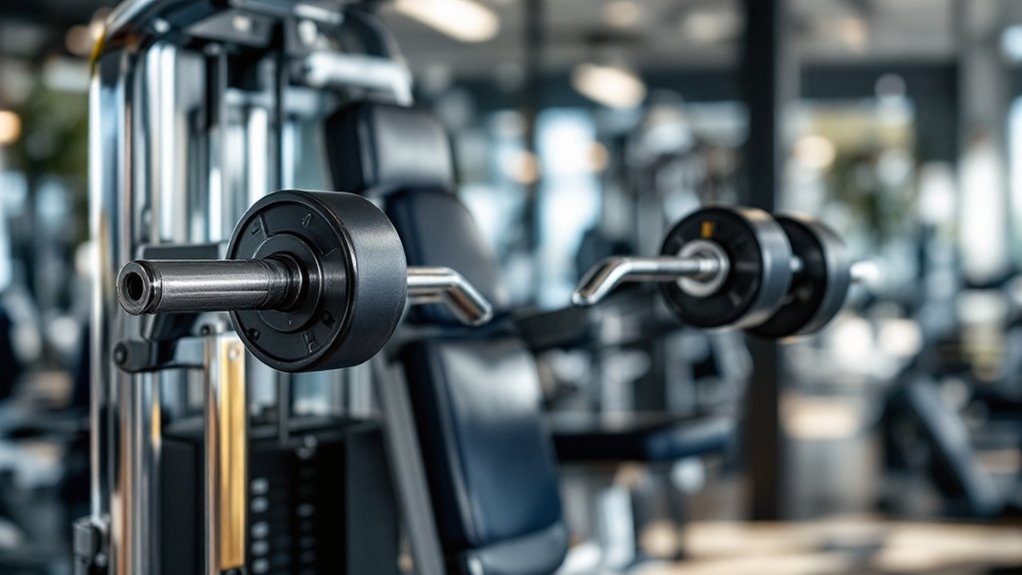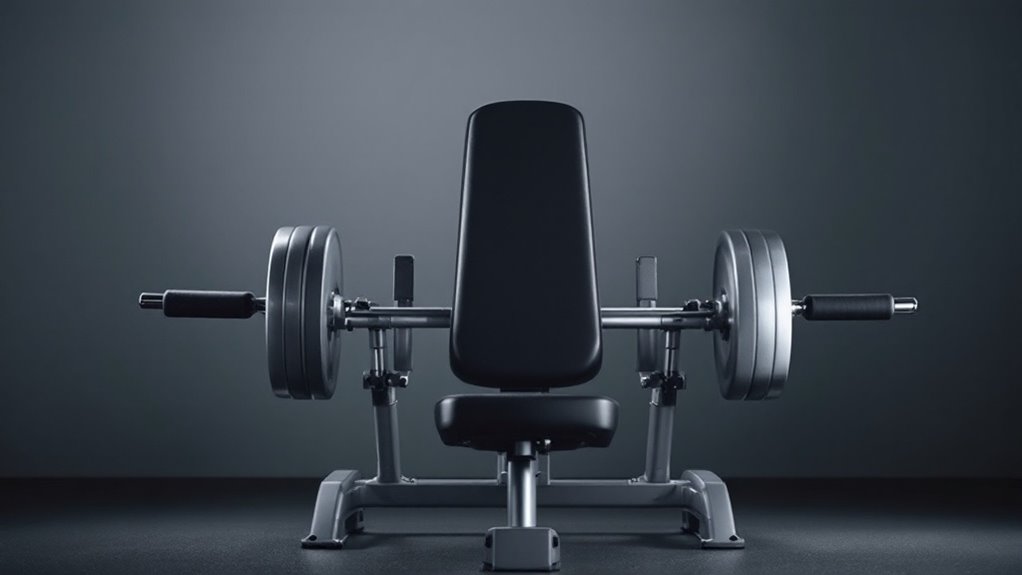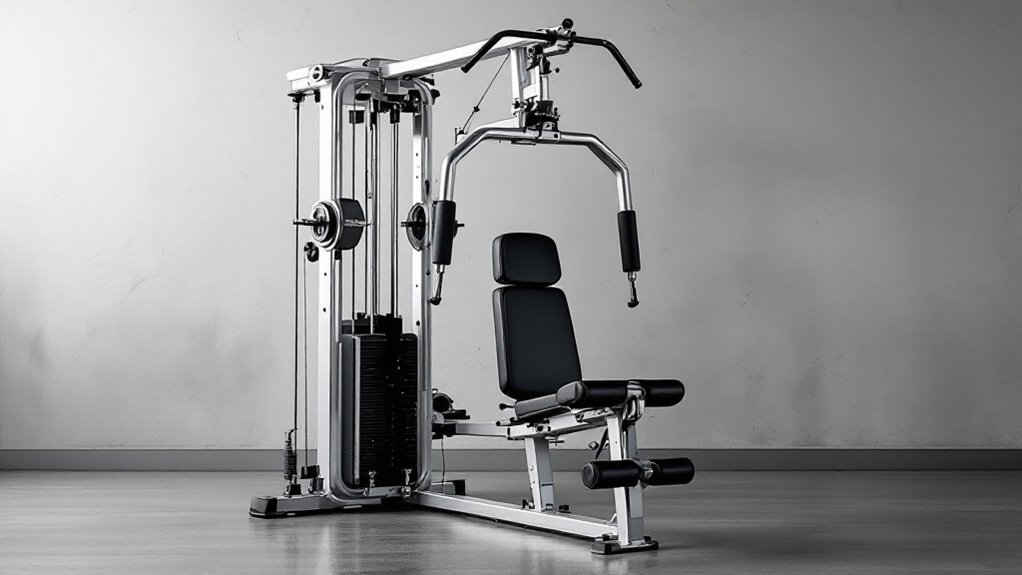Biceps Curls Machine

The biceps curl machine offers a stable platform for isolating and strengthening the biceps muscles through controlled resistance training. Its fixed movement pattern helps maintain proper form while reducing stress on joints and supporting muscles. The pin-loaded weight system allows for easy progression, making it suitable for both beginners and advanced lifters. When used with proper technique and programming, this machine delivers effective biceps development through targeted isolation. Mastering its mechanics reveals the path to peak arm development.
Key Takeaways
- The biceps curl machine isolates and targets the biceps brachii muscle while providing stable support through a controlled range of motion.
- Maintain flat upper arms on the pads with elbows aligned to the machine's axis for proper form and maximum effectiveness.
- Use a supinated grip at shoulder width while keeping your core engaged and spine neutral throughout the movement.
- Progressive overload can be easily achieved using the pin-loaded weight system, making it suitable for both beginners and advanced lifters.
- Train biceps 2-3 times weekly with 48-hour recovery periods, using controlled movements and 10-20 rep ranges for optimal results.
Key Benefits and Features

The biceps curls machine stands as a cornerstone piece of equipment for those seeking targeted arm development and functional strength. Its specialized design isolates the biceps brachii muscle while engaging supporting muscles like the brachialis and brachioradialis for balanced growth. Using slow controlled movements helps maximize muscle engagement and development.
The machine excels in providing mechanical advantages that free weights cannot match. It offers precise muscle targeting, improved grip development, and controlled motion paths that protect joints from excessive stress. The pin-loaded weight system makes it simple for users to adjust resistance levels without interrupting their workout flow. For optimal results, incorporate this exercise into a compound movement routine that targets multiple muscle groups.
With multiple grip variations and unilateral training options, users can address strength imbalances while building impressive peak contractions. The machine's versatility supports both beginners and advanced lifters in achieving their arm development goals.
Proper Form and Exercise Execution

Mastering proper form on the biceps curls machine begins with precise setup and intentional execution of each repetition. Proper positioning and alignment are vital for maximizing results while preventing injury. Maintaining a slow and controlled tempo helps optimize muscle fiber recruitment throughout the exercise. Unilateral training provides an alternative method for isolating each arm independently. Integrating biceps training with compound movements helps develop functional upper body strength.
| Setup Component | Execution Guide |
|---|---|
| Seat Height | Elbows correspond with machine axis |
| Arm Position | Upper arms flat on pads |
| Grip Style | Supinated, shoulder-width |
| Core Engagement | Abdominals braced, spine neutral |
| Breathing Pattern | Exhale up, inhale down |
The movement should be controlled throughout, with emphasis on maintaining upper arm stability while curling through a complete range of motion. A brief pause at peak contraction improves muscle activation and prevents momentum-based cheating.
Training Recommendations and Programming

Successful programming for the biceps curls machine requires careful consideration of multiple training variables to enhance muscle growth and strength development. For best results, perform 2-3 machine curl sessions weekly, allowing 48 hours between workouts. To maximize results from each session, implement proper error handling procedures through careful form monitoring and adjustment. Mind-muscle connection should be evaluated continuously to ensure exercise effectiveness.
Maximize biceps gains through strategic machine training, incorporating 2-3 weekly sessions with adequate recovery between workouts.
Structure sets within 10-20 rep ranges for hypertrophy, using controlled tempos to increase time under tension. Follow a progressive overload approach by gradually increasing weight or reps each week.
Integrate machine curls into a balanced arm routine by pairing them with free-weight exercises. Consider scheduling these sessions separate from heavy back training days to prevent fatigue interference.
For progression, cycle between different rep schemes and adjust resistance to maintain challenging workouts while preventing adaptation plateaus.
Machine Vs Free Weight Comparison

Making intelligent choices between machines and free weights requires understanding their distinct advantages for biceps training. While machines allow higher resistance loads due to controlled movement paths, free weights involve multiple muscle groups simultaneously through natural stabilization demands. Dumbbells activate core muscles, shoulders, and forearms during biceps exercises, enhancing functional strength development. Proper form should be prioritized to maximize results and prevent injury during strength training. The fixed motion paths of machines can help beginners establish consistent movement patterns before progressing to free weights. Progressive overload is essential for continuous muscle growth regardless of equipment choice.
| Aspect | Machine | Free Weights |
|---|---|---|
| Stability | Controlled | Challenges Balance |
| Muscle Activation | Primary Only | Multiple Groups |
| Load Capacity | Higher | Moderate |
| Functional Transfer | Limited | Extensive |
This comparison highlights how machines isolate the biceps while free weights promote thorough muscle involvement through destabilized lifting patterns.
Frequently Asked Questions
Can Pregnant Women Safely Use the Biceps Curl Machine?
Pregnant women can safely use biceps curl machines with proper modifications and precautions.
Pin-loaded machines offer controlled resistance and stability advantages over free weights.
Key safety measures include lightened loads, controlled movements, proper posture, and seat height adjustments.
Healthcare clearance is necessary for those with specific conditions.
As pregnancy progresses, range of motion should be adjusted, particularly during the third trimester.
How Often Should the Machine Be Maintained or Inspected?
The machine requires a structured maintenance schedule across multiple timeframes.
Daily tasks include exterior cleaning and screw inspections.
Weekly maintenance involves checking belts for damage, lubricating guide rods, and verifying functionality.
Monthly checks focus on seat tube cleaning and mechanism operation.
Yearly maintenance examines harmonic motion systems and potential belt replacement.
Belts need weekly inspections after one year, with immediate replacement if cracks appear.
What Muscles Can I Target by Using a Reverse Grip?
A reverse grip awakens the sleeping giants of the arm, particularly engaging the brachialis and brachioradialis muscles.
While the biceps brachii takes a back seat, the brachialis becomes the powerhouse of elbow flexion.
The forearm muscles, including deep flexors and extensors, receive heightened stimulation.
This grip variation also targets interosseous muscles, enhancing overall arm stability and functional strength development.
Are Biceps Curl Machines Suitable for Rehabilitation After Elbow Surgery?
Biceps curl machines can be suitable for rehabilitation after elbow surgery, but their use must correspond with specific recovery timelines.
Research indicates they should only be introduced 8-10 weeks post-surgery when active biceps contractions are permitted. The machines provide controlled resistance and movement patterns, reducing injury risk.
However, patients must first achieve full passive range of motion and follow therapist guidance on resistance levels.
Does Hand Placement Affect Which Part of the Biceps Gets Worked?
Hand placement greatly affects biceps activation patterns during curls. A close grip (hands 3-5 inches apart) emphasizes the long head of the biceps, while a wider grip targets the short head more intensely.
Closer grips typically reduce range of motion but improve peak contraction. Wide grips allow heavier loads but may compromise isolation.
Alternating between grip widths helps prevent muscle imbalances and guarantees complete development.
Final Thoughts
Like a skilled sculptor crafting their masterpiece, mastering the biceps curl machine can transform arms from untrained clay into chiseled works of art. While both machine and free weights have their place in the iron arena, this steadfast ally provides a reliable path for beginners and veterans alike. When executed with proper form and strategic programming, the biceps curl machine stands as a valuable weapon in any strength training arsenal.


